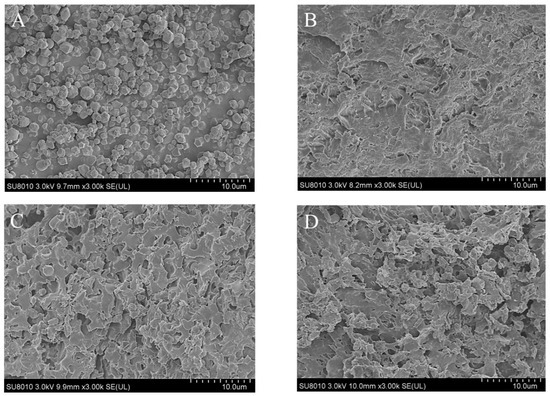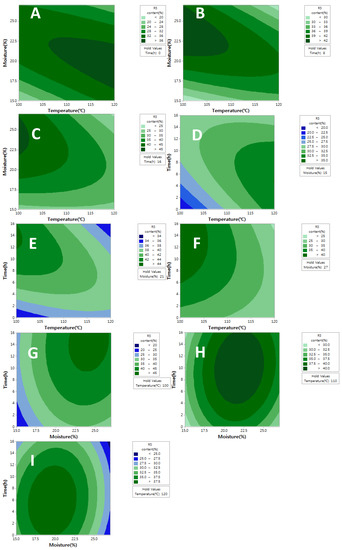Starch Chemistry in Food Products
(Closed)
A topical collection in Molecules (ISSN 1420-3049). This collection belongs to the section "Food Chemistry".
Viewed by 7375
Share This Topical Collection
Editors
 Prof. Dr. Hyun-Jung Chung
Prof. Dr. Hyun-Jung Chung
 Prof. Dr. Hyun-Jung Chung
Prof. Dr. Hyun-Jung Chung
E-Mail
Website
Collection Editor
Division of Food and Nutrition, Chonnam National University, 77 Yongbong-ro, Buk-gu, Gwangju 61186, Republic of Korea
Interests: starch chemistry; structure–function relationship of starch; development of functional starch-based foods; novel utilization of carbohydrate in food products; food applications of modified starches; development of gluten-free food products
Special Issues, Collections and Topics in MDPI journals
 Dr. Xing Zhou
Dr. Xing Zhou
 Dr. Xing Zhou
Dr. Xing Zhou
E-Mail
Website
Collection Editor
School of Food Science and Technology, Jiangnan University, Wuxi 214122, China
Interests: starch science; grain processing
Topical Collection Information
Dear Colleagues,
Amongst the biopolymers in nature, starch has received the most attention with respect to its nutritive value and structure–function relations in food and non-food industrial products and applications. Starch and products derived from starch are the major components in food products and can be used to affect the physical properties of many foods. Starches from different sources and genotypes within such sources show substantial diversity in terms of their composition, amylose and amylopectin structure, and structural arrangement of the starch granules, which contribute to different physicochemical properties and thus different functionalities. The desire to deepen our understanding of the relationship between starch structure and functionalities in food systems leads to a highly interesting scientific field. Research on the effects of chemical, enzymatic, and physical modifications of native starches has further improved their properties and expanded the spectrum of starch applications in food systems. In addition, various physical processing techniques such as heat, shear, and moisture regulation highly influence the structure of starch molecules and interactions with other biomolecules and food additives, as well as the sensory and nutritional qualities of final food products. The impact of these interactions on the sensory and nutritional qualities of foods and their safety have been the focus of a number of recent research studies. The current research is also geared towards the importance of starch in human nutrition and health. A new challenge for the food industry is to supply consumers with starch-containing foods with improved nutritional quality. The different forms of starch in foods and novel food processing techniques and their influence on starch digestibility have received tremendous research focus. This topical collection of Molecules aims to acquire in-depth knowledge about some of the aforementioned research concepts in starches and their application in food products.
Prof. Dr. Hyun-Jung Chung
Dr. Xing Zhou
Collection Editors
Manuscript Submission Information
Manuscripts should be submitted online at www.mdpi.com by registering and logging in to this website. Once you are registered, click here to go to the submission form. Manuscripts can be submitted until the deadline. All submissions that pass pre-check are peer-reviewed. Accepted papers will be published continuously in the journal (as soon as accepted) and will be listed together on the collection website. Research articles, review articles as well as short communications are invited. For planned papers, a title and short abstract (about 100 words) can be sent to the Editorial Office for announcement on this website.
Submitted manuscripts should not have been published previously, nor be under consideration for publication elsewhere (except conference proceedings papers). All manuscripts are thoroughly refereed through a single-blind peer-review process. A guide for authors and other relevant information for submission of manuscripts is available on the Instructions for Authors page. Molecules is an international peer-reviewed open access semimonthly journal published by MDPI.
Please visit the Instructions for Authors page before submitting a manuscript.
The Article Processing Charge (APC) for publication in this open access journal is 2700 CHF (Swiss Francs).
Submitted papers should be well formatted and use good English. Authors may use MDPI's
English editing service prior to publication or during author revisions.
Keywords
- starch functionality
- starch structure
- food application of starch
- novel starch development
- modified starch
- grain-based products
- novel food processing in starch-based foods
- starch and health
Published Papers (3 papers)
Open AccessArticle
Preparation of Neohesperidin–Taro Starch Complex as a Novel Approach to Modulate the Physicochemical Properties, Structure and In Vitro Digestibility
by
Youming Zuo, Zirui He, Weidong Yang, Chongde Sun, Xingqian Ye, Jinhu Tian and Xiangli Kong
Cited by 1 | Viewed by 1846
Abstract
Neohesperidin (NH), a natural flavonoid, exerts multiple actions, such as antioxidant, antiviral, antiallergic, vasoprotective, anticarcinogenic and anti-inflammatory effects, as well as inhibition of tumor progression. In this study, the NH–taro starch complex is prepared, and the effects of NH complexation on the physicochemical
[...] Read more.
Neohesperidin (NH), a natural flavonoid, exerts multiple actions, such as antioxidant, antiviral, antiallergic, vasoprotective, anticarcinogenic and anti-inflammatory effects, as well as inhibition of tumor progression. In this study, the NH–taro starch complex is prepared, and the effects of NH complexation on the physicochemical properties, structure and in vitro digestibility of taro starch (TS) are investigated. Results showed that NH complexation significantly affected starch gelatinization temperatures and reduced its enthalpy value (ΔH). The addition of NH increased the viscosity and thickening of taro starch, facilitating shearing and thinning. NH binds to TS via hydrogen bonds and promotes the formation of certain crystalline regions in taro starch. SEM images revealed that the surface of NH–TS complexes became looser with the increasing addition of NH. The digestibility results demonstrated that the increase in NH (from 0.1% to 1.1%, weight based on starch) could raise RS (resistant starch) from 21.66% to 27.75% and reduce RDS (rapidly digestible starch) from 33.51% to 26.76% in taro starch. Our work provided a theoretical reference for the NH–taro starch complex’s modification of physicochemical properties and in vitro digestibility with potential in food and non-food applications.
Full article
►▼
Show Figures
Open AccessArticle
Physicochemical, Structural, and In Vitro Gastrointestinal Tract Release Properties of Sodium Alginate-Based Cryogel Beads Filled with Hydroxypropyl Distarch Phosphate as a Curcumin Delivery System
by
Eun Chae Moon and Yoon Hyuk Chang
Cited by 7 | Viewed by 2386
Abstract
The objectives of this study were to produce sodium alginate (SA)-based cryogel beads filled with different concentrations (0, 0.4, 1.0, and 2.5%,
w/
w) of hydroxypropyl distarch phosphate (HDP) as a curcumin delivery system and to investigate the physicochemical, structural, and
[...] Read more.
The objectives of this study were to produce sodium alginate (SA)-based cryogel beads filled with different concentrations (0, 0.4, 1.0, and 2.5%,
w/
w) of hydroxypropyl distarch phosphate (HDP) as a curcumin delivery system and to investigate the physicochemical, structural, and in vitro gastrointestinal tract release properties of the cryogel beads. According to FT-IR analysis, the formation of ionic crosslinking between SA and Ca
2+ and the presence of HDP were found. XRD analysis demonstrated the successful encapsulation of curcumin in the beads by observing the disappearance of the characteristic peaks of curcumin. SEM analysis results revelated that SA-based cryogel beads exhibited a denser internal structure as the HDP concentration was increased. The encapsulation efficiency of curcumin in SA cryogel beads filled with HDP concentration from 0% to 2.5% was increased from 31.95% to 76.66%, respectively, indicating that HDP can be a suitable filler for the encapsulation of curcumin in the production of SA-based cryogel beads. After exposure to simulated gastric fluid (SGF) and simulated intestinal fluid (SIF), the release rate of curcumin was decreased as HDP concentration was increased. Accordingly, SA-based cryogel beads filled with HDP can be utilized for the delivery system of curcumin in the food industry.
Full article
►▼
Show Figures
Open AccessArticle
Enhancing Resistant Starch Content of High Amylose Rice Starch through Heat–Moisture Treatment for Industrial Application
by
Chang-Seon Lee and Hyun-Jung Chung
Cited by 6 | Viewed by 2404
Abstract
The objective of the present study is to enhance the resistant starch (RS) content of high amylose rice starch with heat–moisture treatment (HMT) for industrial application. The optimized HMT condition for achieving the highest RS content established using response surface methodology (RSM) was
[...] Read more.
The objective of the present study is to enhance the resistant starch (RS) content of high amylose rice starch with heat–moisture treatment (HMT) for industrial application. The optimized HMT condition for achieving the highest RS content established using response surface methodology (RSM) was a temperature of 100 °C, moisture content of 24.2%, and a time of 11.5 h. Upon HMT, the RS content increased from 32.1% for native starch to 46.4% in HMT starch with optimized condition. HMT of the starches reduced the solubility and swelling power. The surface of HMT starch granules was more irregular than native starch. The X-ray diffraction (XRD) peak intensity at 2θ = 5° was greatly reduced by HMT, and the peaks at 22.7° and 24.2° were merged. HMT increased the gelatinization temperature and reduced the gelatinization enthalpy. HMT provides a method for the production of high-yield RS2 with high amylose rice starch in industrial application.
Full article
►▼
Show Figures










